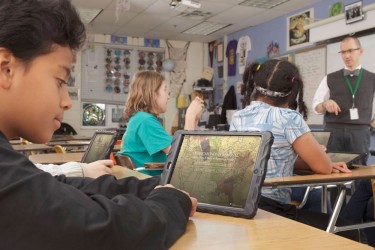Fifty years ago this winter, a young student teacher by the name of Don Rawitsch introduced his eighth grade American history class to a computer game on westward expansion that he had developed along with his colleagues Bill Heinemann and Paul Dillenberger. The game, called The Oregon Trail, would go on to sell over 65 million copies, many of them to educational institutions, making it one of the bestselling games of all time, right up there with Super Mario Bros. and Tetris. But when I talked to Rawitsch recently, he said that when he first came up with the idea, making money was the furthest thing from his mind.
“Back in 1971, there was a lot of activity going on in the world of schools to upgrade curriculum and come up with innovative methods of teaching,” Rawitsch said. Inspired by his teachers at Carleton College in Northfield, Minnesota, Rawitsch decided to pursue new types of pedagogy for his student teacher classes at Jordan Junior High School in Minneapolis. “I was excited and maybe a little naïve,” Rawitsch recalled. “I really wanted to do some things in the classroom that the students were not necessarily used to.” Before developing The Oregon Trail, Rawitsch had attended class with another instructor dressed like Lewis and Clark and attempted to speak and answer questions as the famous explorers. For classes on the Civil War, he tried to recount battles for students through songs that he wrote and performed in class with his guitar. Rawitsch also worked with a track coach at Jordan Junior High on a mock trial assignment for students that began with someone being shot with a starter pistol—the type of innovative pedagogy that most definitely would get you fired today.
For his classes on westward expansion, Rawitsch decided to try something a little safer: a board game with a big map and some toy covered wagons. “In my college work,” Rawitsch said, “I had seen some examples of educational games that were in a box game format … [and] I was kind of fascinated by the idea that this would be something you do in a classroom that would probably be much more interesting to students than just reading about history.” Rawitsch began work on this board game in the apartment he shared with fellow Carleton College student teachers, Paul Dillenberger and Bill Heinemann, who both taught math and dabbled in computer programming. They suggested Rawitsch ditch the paper-and-pencil approach; they would help him convert this game into a computer program that could run on his school’s teletype, a monitorless machine connected via the phone line to a mainframe computer in downtown Minneapolis. The two math teachers sometimes used the machine in their own classrooms; when they weren’t using it, the teletype lived in the school’s janitorial closet.



















